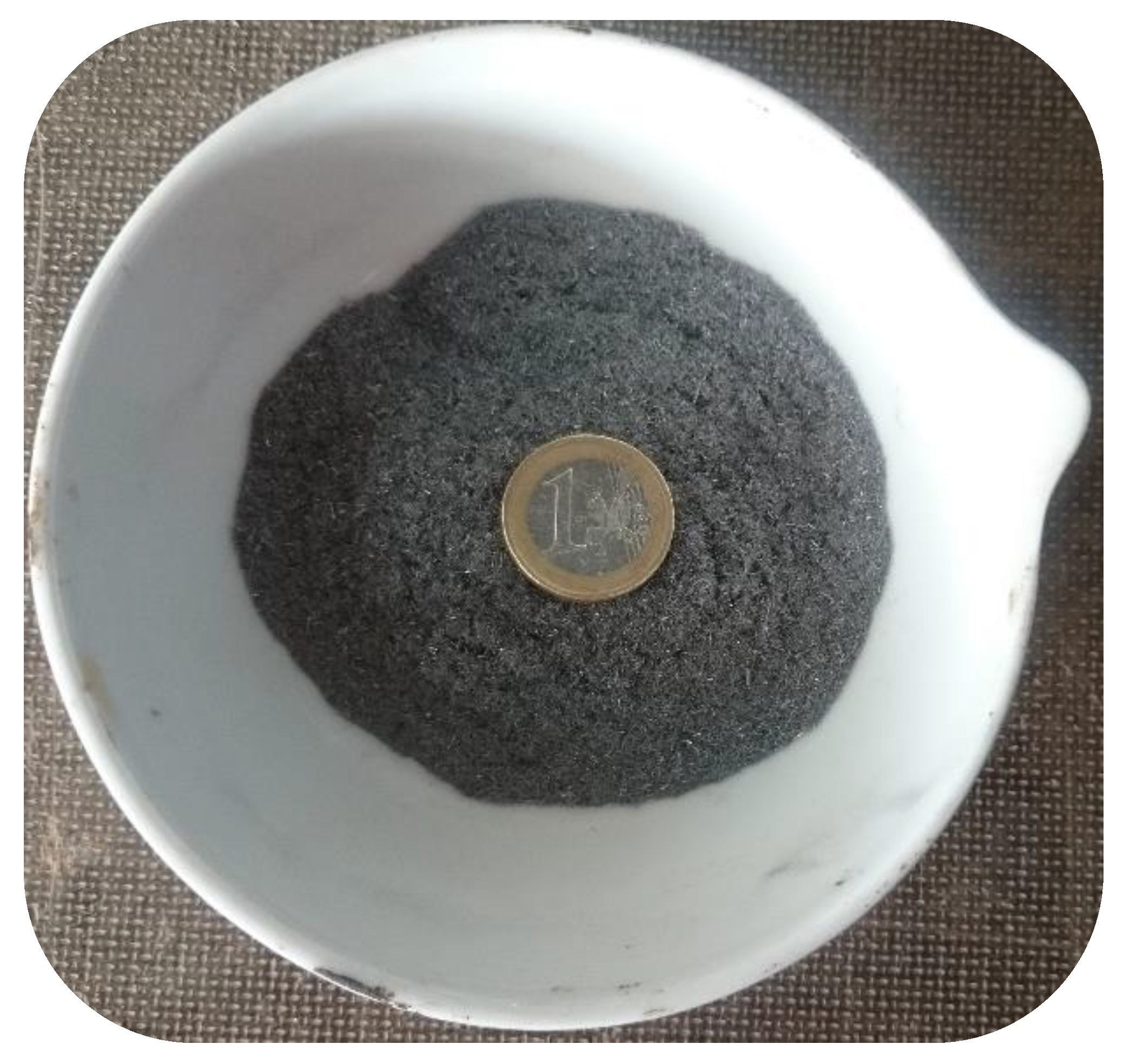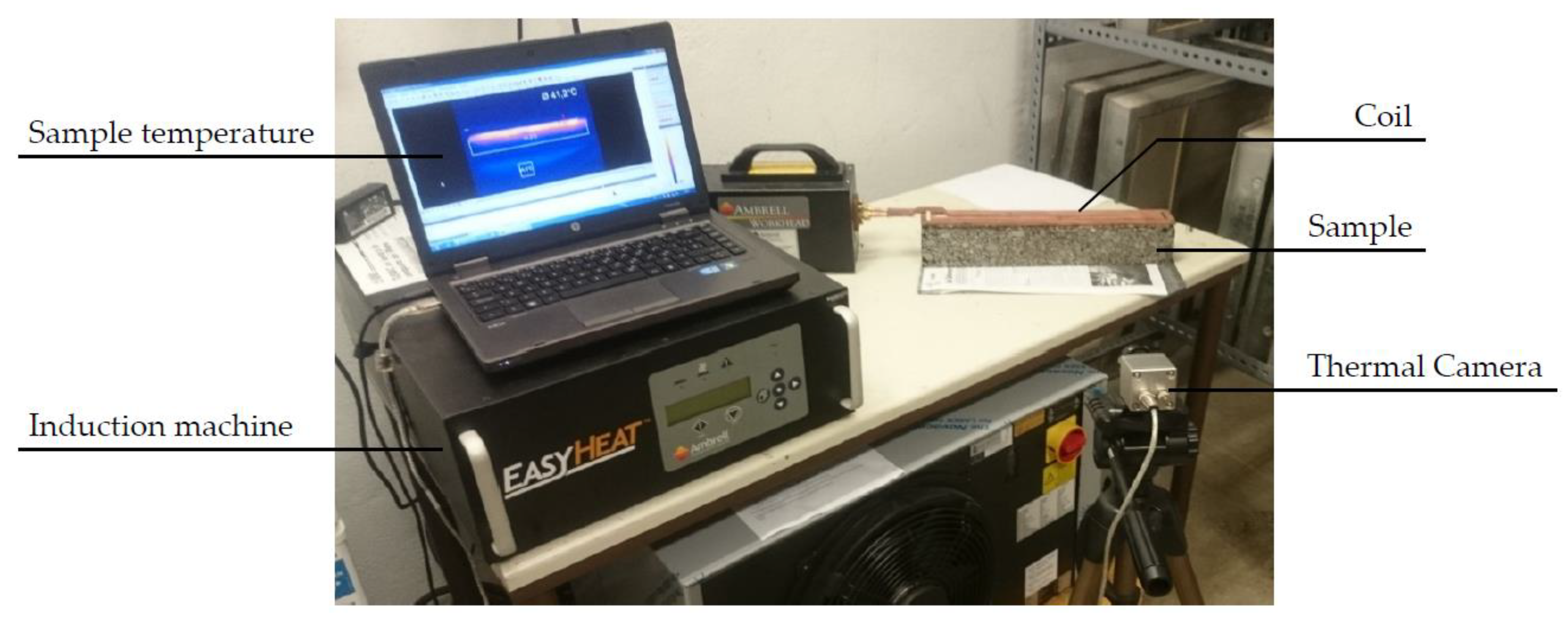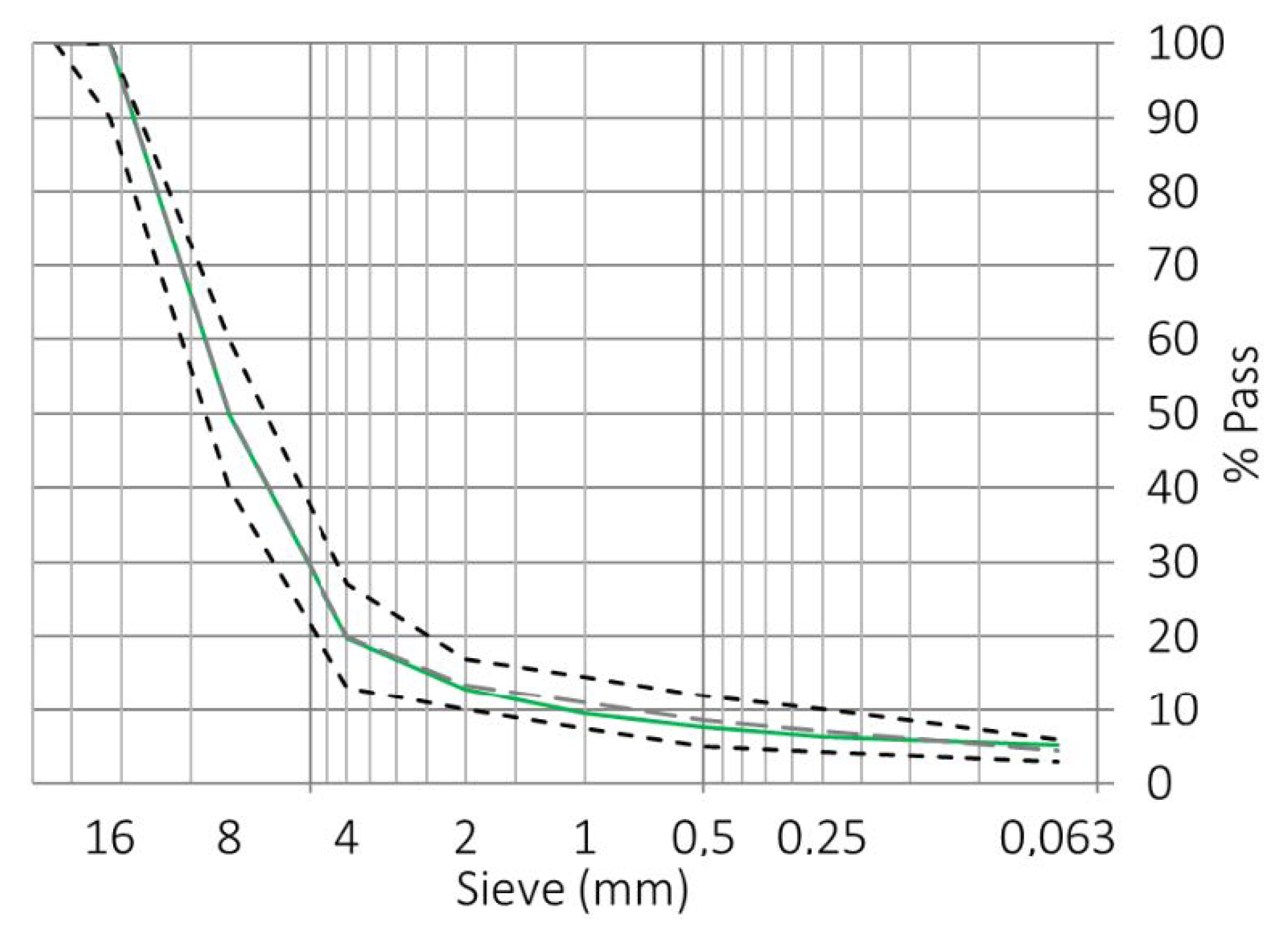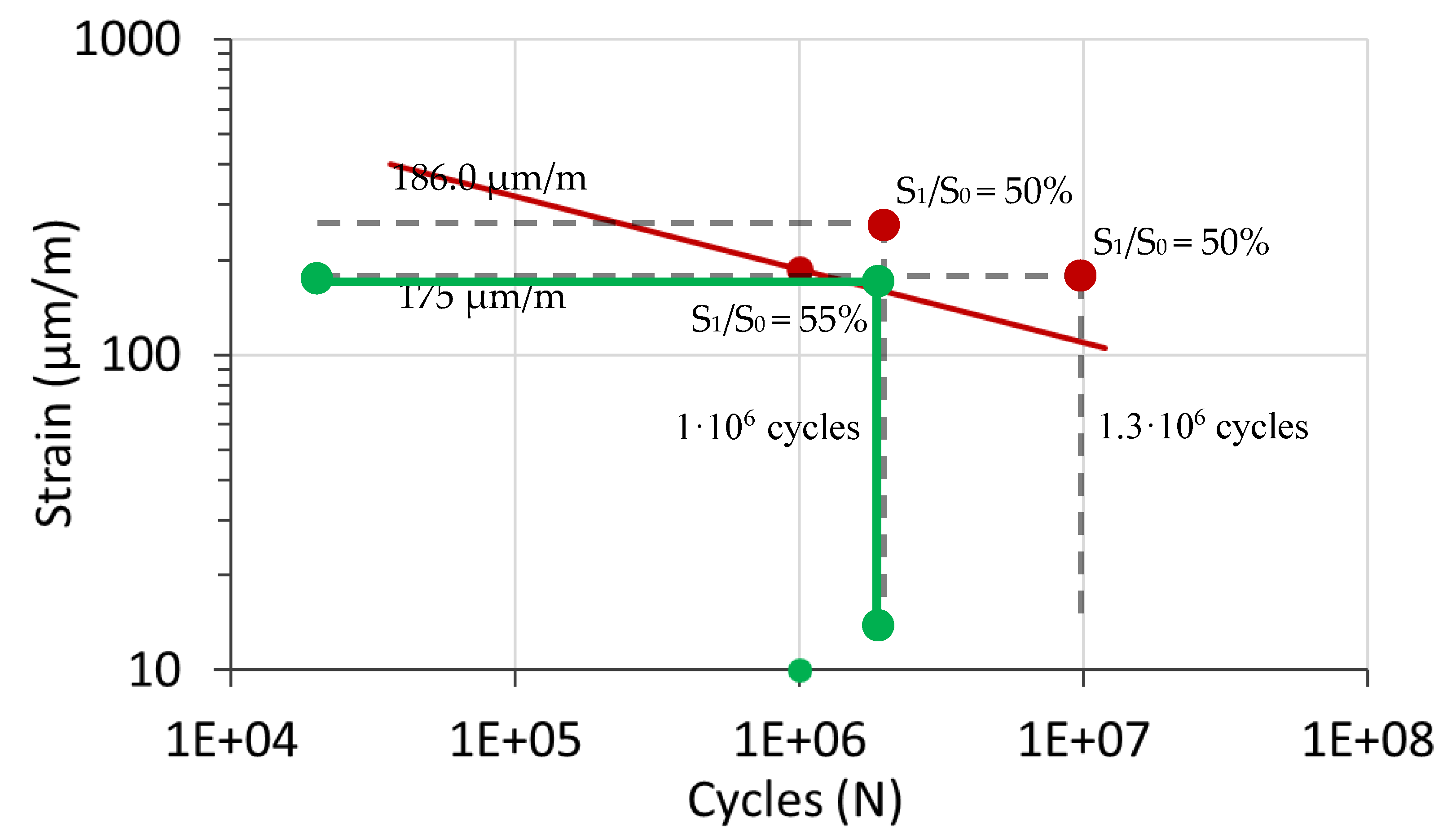Recyclability Potential of Induction-Healable Porous Asphalt Mixtures
Abstract
:1. Introduction
- Porous mixture with healing capacity was artificially aged
- It was used as RA to design a new porous asphalt mixture with healing capacity
- Rejuvenator was added to recover binder properties
- The mechanical and healing properties were not affected
2. Scope and Objective
3. Materials
4. Methodology
5. Results and Discussion
5.1. Design of the New PA Mixture
5.2. Mechanical Performance
5.3. Healing Performance
6. Conclusions
- In terms of mechanical performance, the recyclability of healable porous asphalt mixes is demonstrated. In this research, the mechanical behavior of the recycled porous asphalt mixture with 40% of reclaimed asphalt was quite similar to the original, although both mixtures slightly differ in composition. The experimental mixture has slightly increased its resistance against raveling despite it having a higher percentage of voids. Concerning the water sensitivity test, the experimental mixture showed lower resistances than the original mixture, although the water damage ratio is quite similar. This result is also conditioned by the higher percentage of voids of the experimental mixture. Concerning its stiffness and fatigue resistance, a similar mechanical performance was observed.
- With regard to the healing performance, the recyclability of healable porous asphalt mixes is also demonstrated. The recycled mixture incorporating 40% reclaimed asphalt maintained and even improved the healing capacity of the original healable porous asphalt mixture. This difference is probably due to the small modifications between both mixes, such as the total bitumen or voids content, and the effect of the rejuvenator.
- The addition of the rejuvenator proved to be adequate in terms of both the mechanical and healing performance point of view.
Author Contributions
Funding
Acknowledgments
Conflicts of Interest
References
- Liu, Q.; Cao, D. Research on material composition and performance of porous asphalt pavement. J. Mater. Civ. Eng. 2009, 21, 135–140. [Google Scholar] [CrossRef]
- Andrés-Doménech, I.; Hernández-Crespo, C.; Martín, M.; Andrés-Valeri, V.C. Characterization of wash-off from urban impervious surfaces and SuDS design criteria for source control under semi-arid conditions. Sci. Total Environ. 2018, 612, 1320–1328. [Google Scholar] [CrossRef] [PubMed]
- Barrett, M.E.; Kearfott, P.; Malina, J.F., Jr. Stormwater quality benefits of a porous friction course and its effect on pollutant removal by roadside shoulders. Water Environ. Res. 2006, 78, 2177–2185. [Google Scholar] [CrossRef] [PubMed] [Green Version]
- Andrés-Valeri, V.C.; Rodriguez-Torres, J.; Calzada-Perez, M.A.; Rodriguez-Hernandez, J. Exploratory study of porous asphalt mixtures with additions of reclaimed tetra pak material. Constr. Build. Mater. 2018, 160, 233–239. [Google Scholar] [CrossRef] [Green Version]
- Andrés-Valeri, V.C.; Marchioni, M.; Sañudo-Fontaneda, L.A.; Giustozzi, F.; Becciu, G. Laboratory assessment of the infiltration capacity reduction in clogged porous mixture surfaces. Sustainability 2016, 8, 751. [Google Scholar] [CrossRef] [Green Version]
- Lastra-González, P.; Indacoechea-Vega, I.; Calzada-Pérez, M.A.; Vega-Zamanillo, Á.; Castro-Fresno, D. Assessment of induction heating in the performance of porous asphalt mixtures. Road Mater Pavement Des. 2020, 21, 2302–2320. [Google Scholar] [CrossRef]
- E. European Asphalt Pavement Association. Asphalt in Figures; 2007; pp. 1–5. Available online: http://www.eapa.org/usr_img/asphalt/AsphaltinFigures2007.pdf (accessed on 6 July 2018).
- E. European Asphalt Pavement Association. Asphalt in Figures; 2015; pp. 1–9. Available online: https://eapa.org/wp-content/uploads/2018/07/2015.pdf (accessed on 25 November 2020).
- de la Roche, C.; Van de Ven, M.; Planche, J.P.; Van den Bergh, W.; Grenfell, J.; Gabet, T.; Mouillet, V.; Porot, L.; Farcas, F.; Ruo, C. Hot recycling of bituminous mixtures. RILEM State Art Rep. 2013, 9, 361–428. [Google Scholar] [CrossRef]
- C. de Estudios y Experimentación de Obras Públicas (CEDEX), Reciclado de Pavimentos Asfálticos. 2015. Available online: http://www.cedexmateriales.es/upload/docs/es_recicladodepavimentosasfalticosnov2015.pdf (accessed on 25 November 2020).
- Sánchez, A.E. Efecto del Tipo de Aditivo en el Comportamiento de Mezclas Bituminosas a Diferentes Temperaturas de Fabricación y Compactación. Ph.D. Thesis, Universidad de Cantabria, Cantabria, Spain, 2012. Available online: https://www.educacion.gob.es/teseo/mostrarRef.do?ref=996474 (accessed on 25 November 2020).
- Baghaee, M.T.; Baaj, H. The use of rejuvenating agents in production of recycled hot mix asphalt: A systematic review. Constr. Build. Mater. 2016, 114, 805–816. [Google Scholar] [CrossRef]
- Abed, A.; Thom, N.; Presti, D.L. Design considerations of high RAP-content asphalt produced at reduced temperatures. Mater. Struct. Constr. 2018, 51. [Google Scholar] [CrossRef] [Green Version]
- Lastra-González, P.; Calzada-Pérez, M.A.; Castro-Fresno, D.; Indacoechea-Vega, I. Asphalt mixtures with high rates of recycled aggregates and modified bitumen with rubber at reduced temperature. Road Mater. Pavement Des. 2018, 19. [Google Scholar] [CrossRef] [Green Version]
- Rodríguez-Fernández, I.; Lastra-González, P.; Indacoechea-Vega, I.; Castro-Fresno, D. Recyclability potential of asphalt mixes containing reclaimed asphalt pavement and industrial by-products. Constr. Build. Mater. 2019, 195, 148–155. [Google Scholar] [CrossRef]
- Ouyang, J.; Zhao, Z.; Yang, H.; Zhang, Y.; Tang, A. Large-scale synthesis of sub-micro sized halloysite-composed CZA with enhanced catalysis performances. Appl. Clay Sci. 2018, 152, 221–229. [Google Scholar] [CrossRef]
- Corrado, A.; Polini, W. Measurement of high flexibility components in composite material by touch probe and force sensing resistors. J. Manuf. Process. 2019, 45, 520–531. [Google Scholar] [CrossRef]
- Lu, D.X.; Saleh, M. Laboratory evaluation of warm mix asphalt incorporating high RAP proportion by using evotherm and sylvaroad additives. Constr. Build. Mater. 2016, 114, 580–587. [Google Scholar] [CrossRef]
- Wang, F.; Xie, Z.; Liang, J.; Fang, B.; Piao, Y.; Hao, M.; Wang, Z. Tourmaline-Modified FeMnTiOx Catalysts for Improved Low-Temperature NH3-SCR Performance. Environ. Sci. Technol. 2019, 53, 6989–6996. [Google Scholar] [CrossRef] [PubMed]
- Aurangzeb, Q.; Al-Qadi, I.L. Asphalt pavements with high reclaimed asphalt pavement content: Economic and environmental perspectives. Transp. Res. Rec. 2014, 2456, 161–169. [Google Scholar] [CrossRef]
- Xu, S.; García, A.; Su, J.; Liu, Q.; Tabaković, A.; Schlangen, E. Self-Healing Asphalt Review: From Idea to Practice. Adv. Mater. Interfaces 2018. [Google Scholar] [CrossRef]
- Gómez-Meijide, B.; Ajam, H.; Lastra-González, P.; Garcia, A. Effect of ageing and RAP content on the induction healing properties of asphalt mixtures. Constr. Build. Mater. 2018, 179. [Google Scholar] [CrossRef]
- Bocci, E.; Prosperi, E.; Mair, V.; Bocci, M. Ageing and Cooling of Hot-Mix-Asphalt during Hauling and Paving—A Laboratory and Site Study. Sustainability 2020, 12, 8612. [Google Scholar] [CrossRef]
- Porot, L.; Broere, D.; Wistuba, M.; Grönniger, J. Asphalt and binder evaluation of asphalt mix with 70% reclaimed asphalt. Road Mater. Pavement Des. 2017, 18, 66–75. [Google Scholar] [CrossRef]
- Tuner, P.; Taylor, A.; Tran, N. Laboratory Evaluation of SYLVAROADTM RP 1000 Rejuvenator 2015. Available online: http://www.eng.auburn.edu/research/centers/ncat/files/reports/2015/rep15-03.pdf (accessed on 25 November 2020).
- Minitserio de Fomento; Spanish Goverment. Orden FOM/2523/2014, Por la Que se Actualizan Determinados Artículos del Pliego de Prescripciones Técnicas Generales Para Obras de Carreteras y Puentes, Relativos a Materiales Básicos, a Firmes y Pavimentos, y a Señalización, Balizamiento y Sistemas de Contención de Vehículos. 2015. Available online: https://www.boe.es/boe/dias/2015/01/03/pdfs/BOE-A-2015-48.pdf (accessed on 25 November 2020).





| Result | Standard | |
|---|---|---|
| Ophite | ||
| Angels coefficient | 16 | EN 1097-2 |
| Specific weight (g/cm3) | 2.937 | EN 1097-6 |
| Polished stone value (PSV) | >56 | EN 1097-8 |
| Flakiness Index (%) | 8 | EN 933-3 |
| Limestone | ||
| Angels coefficient | 28 | EN 1097-2 |
| Specific weight (g/cm3) | 2.725 | EN 1097-6 |
| Sand equivalent | 78 | EN 933-8 |
| Result | Standard | |
|---|---|---|
| Penetration at 25 °C (dmm) | 57 | EN 1426 |
| Softening point (°C) | 51.6 | EN 1427 |
| Fraass point (°C) | −13 | EN 12593 |
| Density (g/cm3) | 1.035 | EN 15326 |
| Flash Point (°C) | Viscosity at 60 °C (Cst) | Density (g/cm3) | Cloud Point (°C) |
|---|---|---|---|
| >280 | 22 | 0.93 | <−25 |
| Material | % w/w |
|---|---|
| Ophitic (coarse aggregate) | 85.7 |
| Limestone (fine aggregate + filler) | 13.2 |
| Steel Fibers | 1.1 |
| Bitumen/mixture (%) | 4.5 |
| RA Binder | |
|---|---|
| Penetration (dmm) | 25 |
| Ring and ball (°C) | 63.6 |
| Penetration index | 0.2 |
| Material | % w/w |
|---|---|
| Ophitic (coarse aggregate) | 52.7 |
| Limestone (fine aggregate + filler) | 7.2 |
| RA (aged healing PA mixture) | 39.2 |
| New steel fibers | 0.8 |
| Experimental PA | Original PA | |
|---|---|---|
| Density (g/cm3) | 2.097 ± 0.017 | 2.121 ± 0.006 |
| Voids in mixture (%) | 22.1 ± 0.6 | 20.8 ± 0.2 |
| Loss particle (%) | 17.5 ± 1.7 | 20.9 ± 6.9 |
| Experimental PA | Original PA | |||
|---|---|---|---|---|
| Dry | Wet | Dry | Wet | |
| I.T.S. (KPa) | 1040.0 ± 70.2 | 864.1 ± 60.1 | 1319.8 ± 43.5 | 1125.9 ± 18.7 |
| I.T.S.R. (%) | 83 | 85 | ||
| Experimental PA | Original PA | |||||||
|---|---|---|---|---|---|---|---|---|
| Frequency | Dynamic Modulus ± Deviation | Phase Angle ± Deviation | Dynamic Modulus ± Deviation | Phase Angle ± Deviation | ||||
| (Hz) | (MPa) | (°) | (MPa) | (°) | ||||
| 0.1 | 278 | 21 | 49.1 | 3 | 343 | 17 | 49.4 | 1 |
| 0.2 | 358 | 47 | 47.6 | 3 | 413 | 29 | 48.9 | 1 |
| 0.5 | 486 | 63 | 46.2 | 2 | 548 | 48 | 47.4 | 1 |
| 1 | 617 | 78 | 44.8 | 2 | 684 | 68 | 45.7 | 1 |
| 2 | 785 | 87 | 42.9 | 1 | 866 | 98 | 43.4 | 1 |
| 5 | 1083 | 103 | 40.1 | 1 | 1177 | 152 | 40.3 | 1 |
| 8 | 1283 | 119 | 38.2 | 1 | 1384 | 189 | 38.3 | 1 |
| 10 | 1383 | 123 | 37.5 | 1 | 1486 | 206 | 37.7 | 1 |
| 20 | 1774 | 156 | 34.9 | 0 | 1882 | 272 | 34.7 | 1 |
| 30 | 2055 | 179 | 33.4 | 0 | 2161 | 315 | 32.8 | 1 |
| S0 (MPa) | Strain-Characteristic * (µm/m) | Fatigue Line | R2 | |
|---|---|---|---|---|
| Experimental PA | 1700 | 186.0 | 0.81 | |
| Original PA | 2103 | 171.9 | 0.93 |
| Fatigue 1 | Fatigue 2 | Final | |||||||
|---|---|---|---|---|---|---|---|---|---|
| Cycles | ε (µm/m) | S1/S0 (%) | Deviation S1/S0 (%) | ε (µm/m) | S1/S0 (%) | Cycles | Deviation Cycles | Total Cycles | H.R. |
| 1,000,000 | 174.0 | 57.4 | 2.0 | 173.9 | 50.0 | 1,800,484 | 392,643 | 2,800,484 | 2.1 |
Publisher’s Note: MDPI stays neutral with regard to jurisdictional claims in published maps and institutional affiliations. |
© 2020 by the authors. Licensee MDPI, Basel, Switzerland. This article is an open access article distributed under the terms and conditions of the Creative Commons Attribution (CC BY) license (http://creativecommons.org/licenses/by/4.0/).
Share and Cite
Lastra-González, P.; Indacoechea-Vega, I.; Calzada-Pérez, M.A.; Castro-Fresno, D. Recyclability Potential of Induction-Healable Porous Asphalt Mixtures. Sustainability 2020, 12, 9962. https://doi.org/10.3390/su12239962
Lastra-González P, Indacoechea-Vega I, Calzada-Pérez MA, Castro-Fresno D. Recyclability Potential of Induction-Healable Porous Asphalt Mixtures. Sustainability. 2020; 12(23):9962. https://doi.org/10.3390/su12239962
Chicago/Turabian StyleLastra-González, Pedro, Irune Indacoechea-Vega, Miguel A. Calzada-Pérez, and Daniel Castro-Fresno. 2020. "Recyclability Potential of Induction-Healable Porous Asphalt Mixtures" Sustainability 12, no. 23: 9962. https://doi.org/10.3390/su12239962





